 It is easy to be caught up in a lifestyle in which competitive market-driven forces whip up a frenzy of ‘need’ for bigger, brighter, newer and supposedly better. Through glossy advertising, we’re sold an illusion that happiness and satisfaction can be bought with the latest and greatest material possessions. Even the promotion of ‘light-green’ or so-called sustainable living often involves buying more stuff.
It is easy to be caught up in a lifestyle in which competitive market-driven forces whip up a frenzy of ‘need’ for bigger, brighter, newer and supposedly better. Through glossy advertising, we’re sold an illusion that happiness and satisfaction can be bought with the latest and greatest material possessions. Even the promotion of ‘light-green’ or so-called sustainable living often involves buying more stuff.
So it is refreshing to hear discussion about how to move beyond growth economics and towards a ‘steady-state’ economy, with a focus on simpler, less consumptive ways of living.
Last week at the University of New South Wales, the 2014 Australian Academy of Science Fenner Conference on the Environment topic was: Addicted to Growth? How to move to a Steady State Economy in Australia This spawned an article about life in a degrowth economy on The Conversation website, written by research fellow at Melbourne Sustainable Society Institute at University of Melbourne, Samuel Alexander.
Alexander writes: “Degrowth would liberate us from the burden of pursuing material excess. We simply don’t need so much stuff – certainly not if it comes at the cost of planetary health, social justice, and personal well-being. Consumerism is a gross failure of imagination, a debilitating addiction that degrades nature and doesn’t even satisfy the universal human craving for meaning.”
He suggests in a degrowth economy, we would grow some of our own food, turn neighbourhoods into urban agricultural landscapes and supplement this with food from local farmers’ markets. And he goes further:
“We do not need to purchase so many new clothes. Let us mend or exchange the clothes we have, buy second-hand, or make our own. In a degrowth society, the fashion and marketing industries would quickly wither away. A new aesthetic of sufficiency would develop, where we creatively re-use and refashion the vast existing stock of clothing and materials, and explore less impactful ways of producing new clothes. We would become radical recyclers and do-it-yourself experts.”
Alexander says “degrowth involves embracing what has been termed the “simpler way” – producing and consuming less. This would be a way of life based on modest material and energy needs but nevertheless rich in other dimensions – a life of frugal abundance. It is about creating an economy based on sufficiency, knowing how much is enough to live well, and discovering that enough is plenty.”
This year I’m embracing that simpler way, every day refashioning clothing that already exists in the world, modelling reduced consumption and thrifty ways of reusing resources rather than buying new with this 365-day Sew it Again project.
But Alexander says: “Actions at the personal and household levels will never be enough, on their own, to achieve a steady-state economy. We need to create new, post-capitalist structures and systems that promote, rather than inhibit, the simpler way of life. These wider changes will never emerge, however, until we have a culture that demands them. So first and foremost, the revolution that is needed is a revolution in consciousness.”
I came to consciousness through Australian rural leadership study last year and I’m part of a REfashion revolution. Today, this starts with a simple but dated cotton circle skirt that I’ve turned into a unique dress. Firstly I unstitched (then hemmed) part of the side-seam to create a neckline. Next, I pinned, tried on, then sewed-up part of the old waistline to turn it into an armhole. The other arm swings free with the bulk of the original skirt, but could be pinned with a brooch or stitched if preferred. The creation of this upcycle involves thinking outside the circle, envisaging something other than the pre-existing cotton skirt and making a simple change to create something original to wear. Changing my small part of the world, one upcycle at a time.
